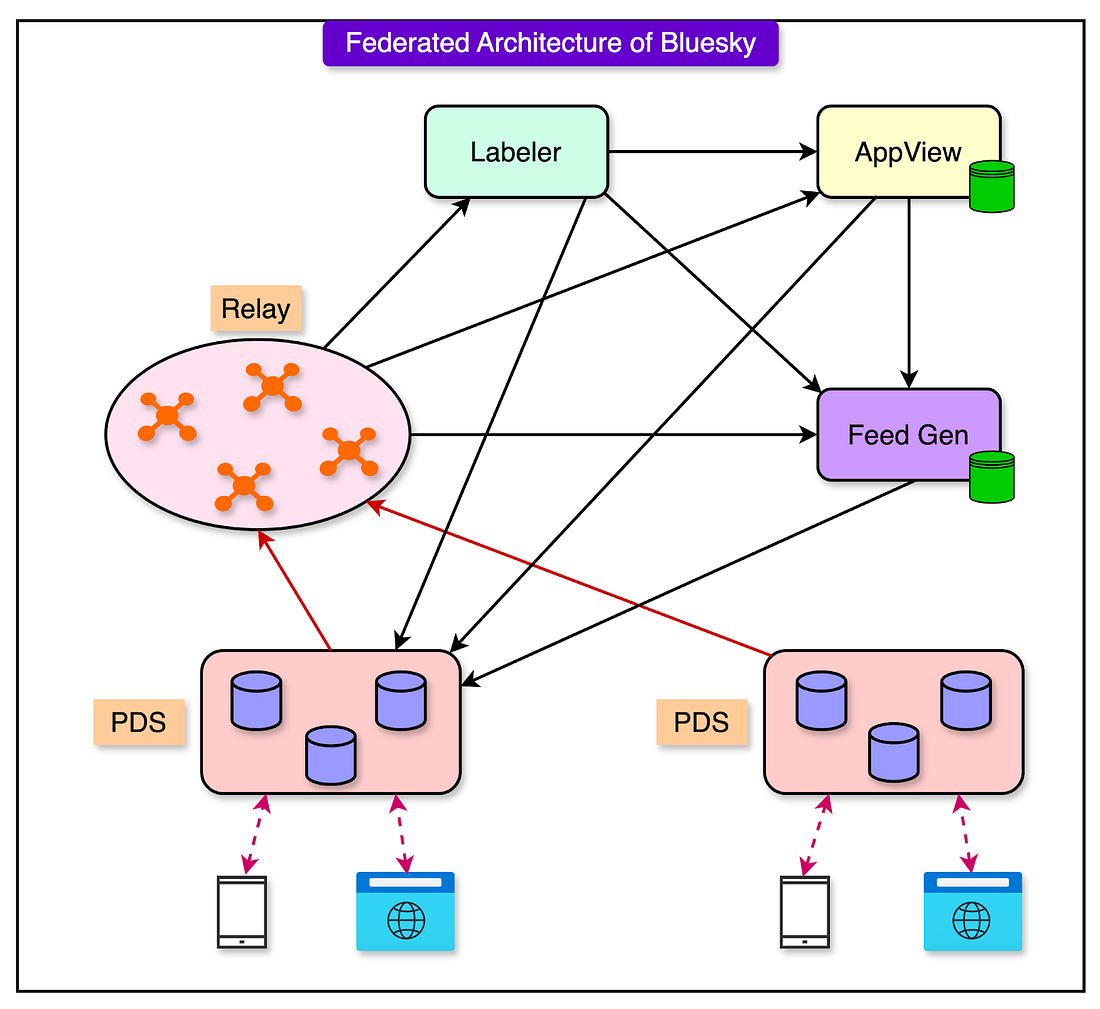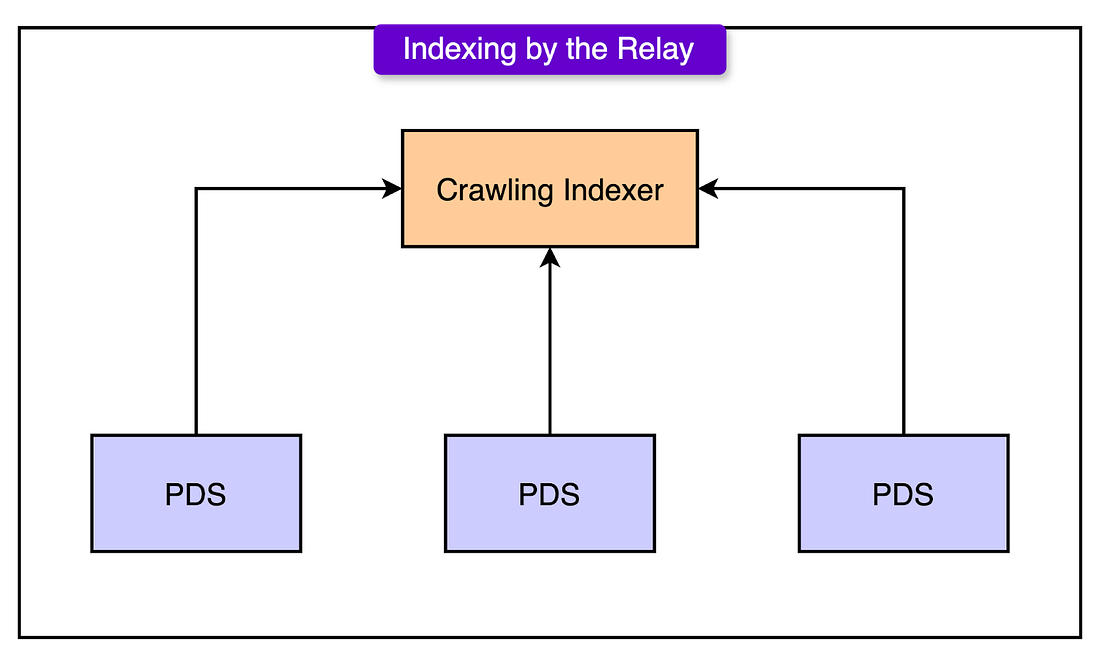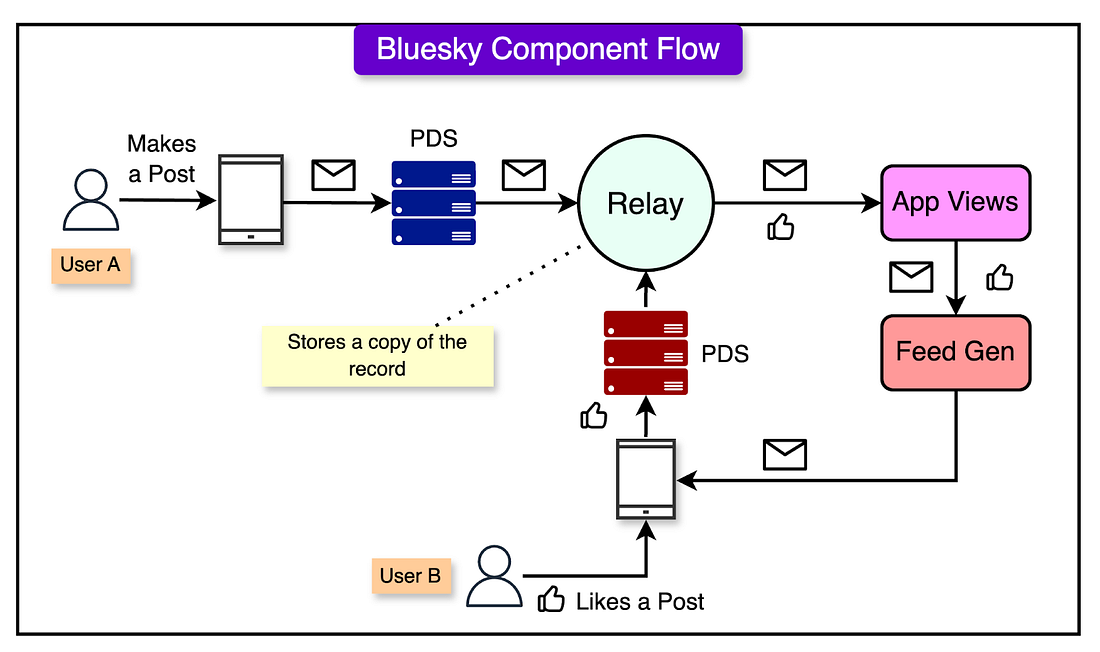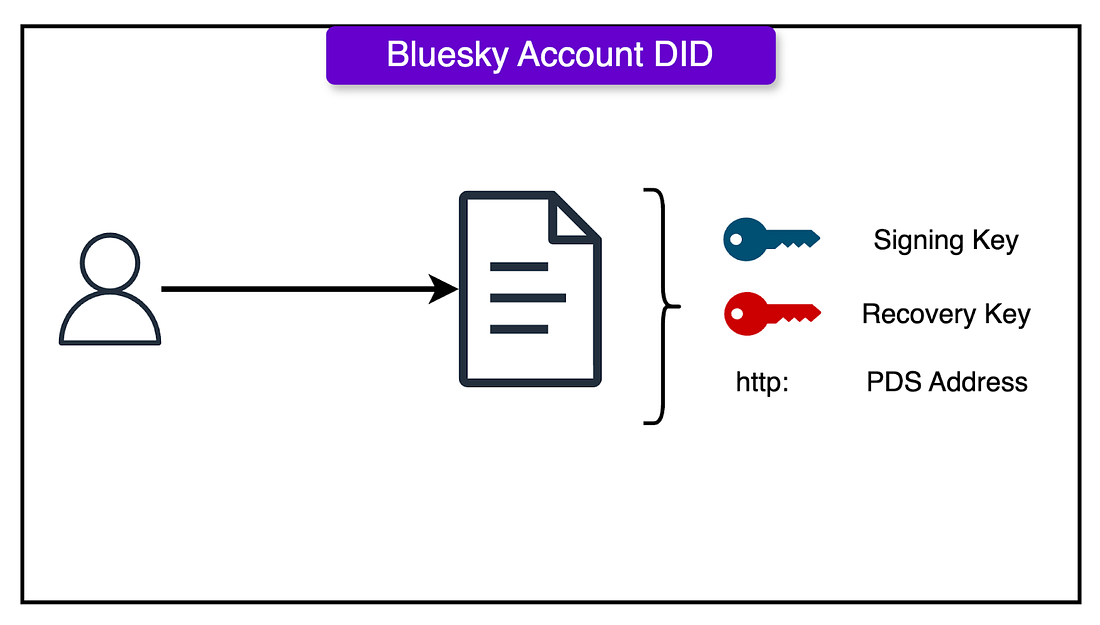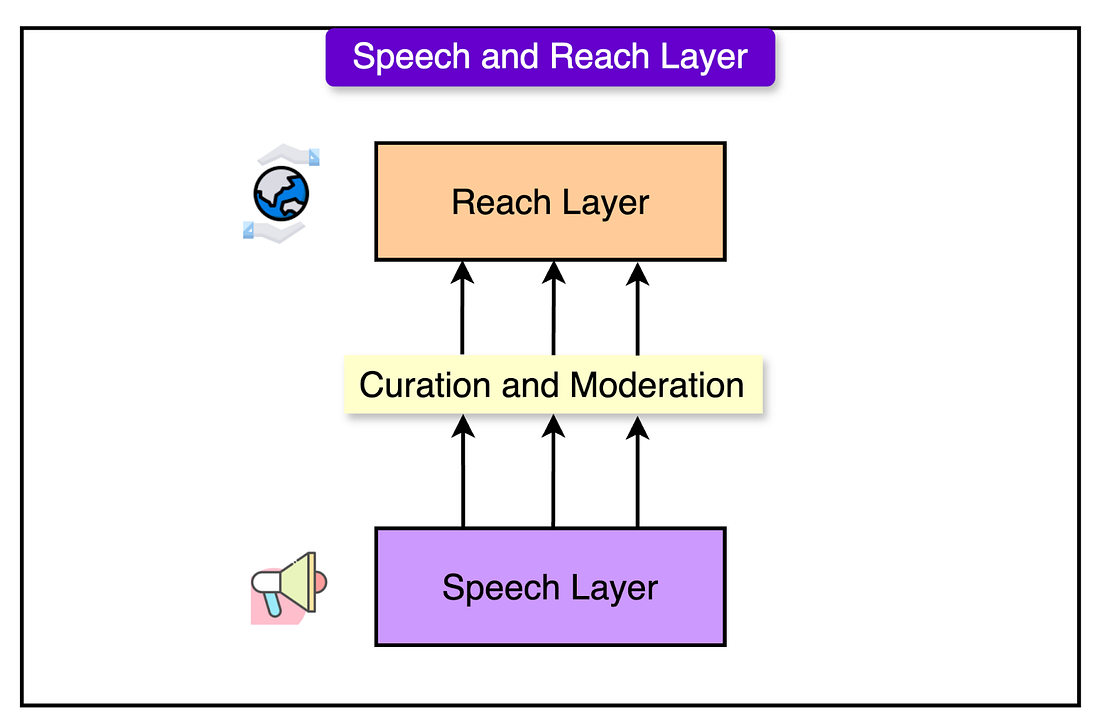Archives
- By thread 5222
-
By date
- June 2021 10
- July 2021 6
- August 2021 20
- September 2021 21
- October 2021 48
- November 2021 40
- December 2021 23
- January 2022 46
- February 2022 80
- March 2022 109
- April 2022 100
- May 2022 97
- June 2022 105
- July 2022 82
- August 2022 95
- September 2022 103
- October 2022 117
- November 2022 115
- December 2022 102
- January 2023 88
- February 2023 90
- March 2023 116
- April 2023 97
- May 2023 159
- June 2023 145
- July 2023 120
- August 2023 90
- September 2023 102
- October 2023 106
- November 2023 100
- December 2023 74
- January 2024 75
- February 2024 75
- March 2024 78
- April 2024 74
- May 2024 108
- June 2024 98
- July 2024 116
- August 2024 134
- September 2024 130
- October 2024 141
- November 2024 171
- December 2024 115
- January 2025 216
- February 2025 140
- March 2025 220
- April 2025 233
- May 2025 239
- June 2025 303
- July 2025 34
-
Reliable and Durable Computer Accessories for Your Needs
Dear info,
I hope this email finds you well. I'm reaching out from Shenzhen Tianfeng International Co., Ltd., a leading manufacturer specializing in high-quality computer accessories.
We offer a range of products, including hard drives, PC motherboards, and power supplies. With over 10 years of experience in the industry, we ensure superior performance and reliability.
We would be delighted to explore potential business opportunities with your company. Please feel free to contact me if you have any questions or need more information.
Best Wishes,
Candy
whatsapp: + 86 18319068061Shenzhen Tianfeng International Technology Co., Ltd.
Website:https://www.skywindintl.com/
Address: 802, Fucheng Digital Innovation Park, No. 15, Shijing Road, Fumin Community, Fucheng Street, Shenzhen, Guangdong, China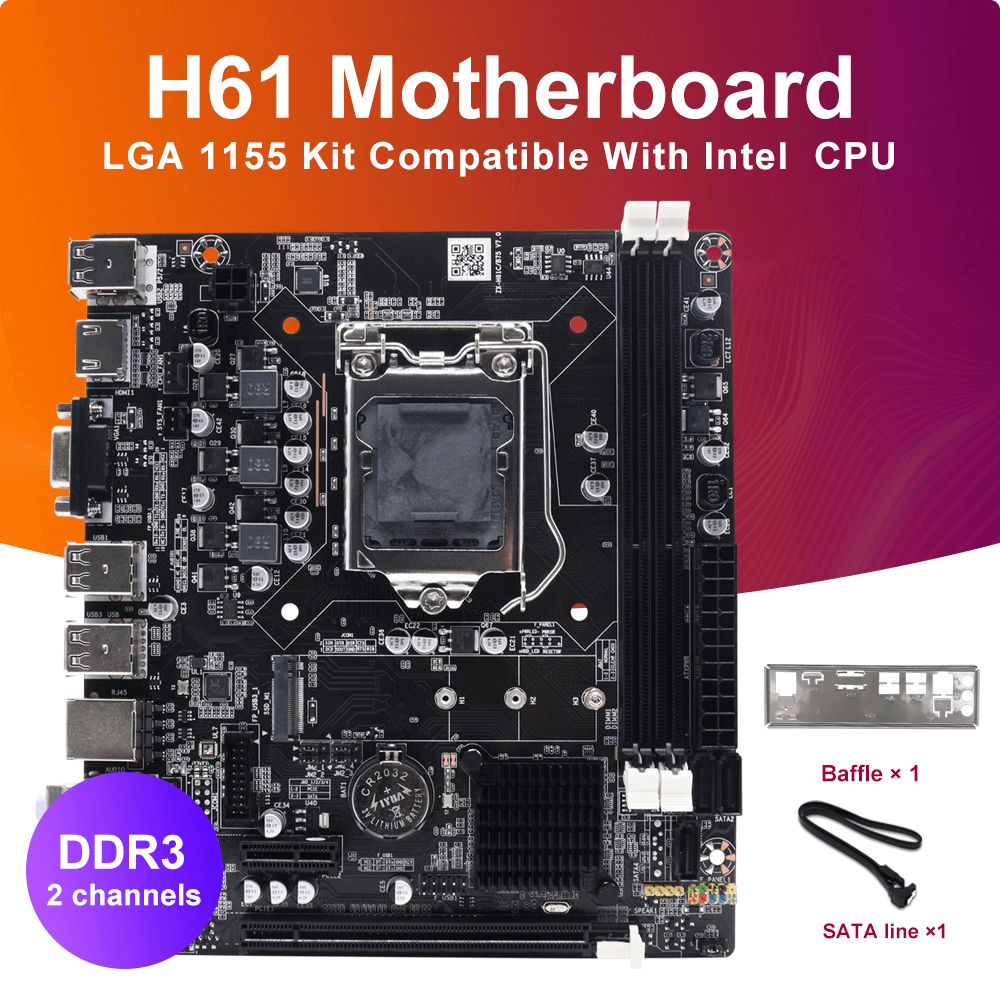
by "Htebazile Aboites" <aboiteshtebazile927@gmail.com> - 05:21 - 26 Mar 2025 -
high-quality aluminum composite panel
Dear Sirs
How are you?
With more than 20 years of experience in metal composites industry, we take pride in providing high-quality aluminum composite panel to our valued clients. Besides,we also develop and offer a wide range of technical products, such as copper composite panel, steel composite panel, for your speical applications.
We believe that our competitive pricing, combined with the same level of quality products, can offer you better alternatives compared to your current suppliers. We have successfully export our panel to various countries such as Europe, Dubai, Saudi Arabia, Qatar, Morroco, Tanzania, Singapore, Malaysia, Australia, Canada, and the United States. Additionally, we have collaborated with renowned Paint brands like PPG, AkzoNobel, and others.
To help you understand our quality and service, could you email me your requirement for the product? We will get back to you very soon with the priced, sample, or further explanation.
Thank you for considering Alucobest as your potential business partner. We look forward to the opportunity of serving you and building a long-lasting mutually beneficial relationship.Best Regards
Ali ZhangExport Team LeaderShanghai Huayuan New Composite Materials Co.,Ltd.No.888, Xin Jin Road, Qingpu Shanghai,ChinaMobile: +86 13003258901 (wechat)www.alucobest.com
by "Tailer Kroni" <kronitailer995@gmail.com> - 05:04 - 26 Mar 2025 -
Trust in AI: How can companies deploy technology responsibly?
On McKinsey Perspectives
The most trusted institutions
by "Only McKinsey Perspectives" <publishing@email.mckinsey.com> - 01:30 - 26 Mar 2025 -
(GV & RB Masterclass) Gary Vee goes OFF on branding!
His Q&A is wild… you gotta see thisYou ready for round 2??
Today in the Gary Vee & Russell Brunson Masterclass Gary Vee comes out swinging!
His presentation is jam-packed with value and insights on how to take your brand big with “unconventional wisdom”.
Think… wave pool on a 100 degree day! That’s how packed this video is with solid gold advice on branding and soooo much more!!
GO WATCH GARY’S VIDEO FROM THE FUNNELS VS BRANDING MASTERCLASS HERE >>
Now, if you’ve followed me for any amount of time, you know I’m all about funnels. I believe in crafting your level 10 offer, driving traffic, and converting that traffic into customers FAST!!
But Gary…. He’s all about branding. He’ll tell you to play the long game… post content, build your audience, and wait for the momentum to take off.
So… who’s right??
Honestly – I think we both are.
In today’s video, you’ll see our two worlds collide!!
GO WATCH GARY'S VIDEO FROM THE GARY VEE & RUSSELL BRUNSON MASTERCLASS HERE >>
And don’t miss tomorrow’s email! We’re diving into how to create viral videos that get MILLIONS of views with the Harmon Brothers!!
See you then!
Russell Brunson
P.S. - Don’t forget, you’re just one funnel away….
P.P.S. If you missed the first Gary Vee & Russell Brunson Masterclass video I sent yesterday, here is the link:
Watch me explain the secret to ClickFunnels viral success HERE >>
© Etison LLC
By reading this, you agree to all of the following: You understand this to be an expression of opinions and not professional advice. You are solely responsible for the use of any content and hold Etison LLC and all members and affiliates harmless in any event or claim.
If you purchase anything through a link in this email, you should assume that we have an affiliate relationship with the company providing the product or service that you purchase, and that we will be paid in some way. We recommend that you do your own independent research before purchasing anything.
Copyright © 2018+ Etison LLC. All Rights Reserved.
To make sure you keep getting these emails, please add us to your address book or whitelist us. If you don't want to receive any other emails, click on the unsubscribe link below.
Etison LLC
3443 W Bavaria St
Eagle, ID 83616
United States
by "Russell | ClickFunnels" <noreply@clickfunnelsnotifications.com> - 01:06 - 26 Mar 2025 -
Get Ahead: AI strategies to elevate your business
Are you set up for AI success? Learn what it takes to thrive in the AI eraGet Ahead: AI strategies to elevate your business
The Agentforce Advantage
Transforming ASEAN Business with AI

Latest innovation
Unleash the Power of Agentforce
Every company has more jobs to be done than resources. That’s why many are turning to Agentforce to build AI agents that work autonomously alongside human employees to support customers, drive efficiencies, and reduce costs.
Find out more 
Data Strategy
How Unified Data is Breaking Barriers to AI in ASEAN
Discover how businesses in ASEAN like FPT Software and UEM Sunrise are unifying data to break silos, fuel AI innovation, and deliver personalised customer experiences.
Read more 
Sales
The Sales AI Playbook: 7 Ways AI Can Help You Close More Deals
Unlock the full potential of AI with tailored use cases, helping your sales team close more deals and boost productivity. Learn how AI can enhance every stage of the sales cycle, from lead generation to final conversion.
Get the playbook 
Analytics and AI
Get ready for AI: What data leaders need to know
Learn what actions you can take to be a more effective leader in today's AI-driven business landscape. Deploy AI the right way, for the right projects, to drive results and improve productivity with Tableau.
Get the guide 
Customer story
ASEAN Trailblazer Spotlight
See how Singapore’s largest retailer FairPrice Group empowers customer service teams, enhances capabilities, and improves efficiency with AI tools.
Read the full story here What's On

On Demand Webinar
Unlocking Growth: AI and Tech Strategies for SMB Success in 2025
On Demand Webinar
The Power of Two: CRM Unlocked with Salesforce + Slack
Join this webinar to discover the future of CRM in Slack, the conversational interface for work and see how Humans and Agents drive customer success together with Salesforce and Slack

On Demand Webinar
The Power of Two: Insights made easy with Salesforce + Tableau
On Demand Webinar
Actionable AI: Power Agentforce to Action Anywhere with MuleSoft
Join this on-demand webinar to learn how to connect AI agents to any third-party systems you use every day, empowering them to take action.
© 2025 Salesforce, Inc.
Salesforce.com Singapore Pte Ltd. 5 Temasek Boulevard #13-01 Suntec Tower 5 Singapore 038985
General Inquiries: +65 6302 5700 | Fax: +65 6302 5777 | Sales: 800 1301 448 (Singapore), 800 967 655 (Hong Kong), +65 6302 5700 (Intl)


This email was sent to info@learn.odoo.com
Manage Preferences to Unsubscribe | View as webpage | Privacy Statement
Powered by Salesforce Marketing Cloud



by "Salesforce" <salesforce@mail.salesforce.com> - 10:32 - 25 Mar 2025 -
Important Update on the UK Matrix Project + Introducing The Executive Mastermind
Important Update on the UK Matrix Project + Introducing The Executive Mastermind
Hi MD Abul,
I wanted to share an important update on the UK Matrix Project—an initiative we’re closely following—and introduce something new that we’re really excited about: The Executive Mastermind.
UK Matrix Project Update
The UK Matrix Project continues to gain momentum, providing critical insights into ERP trends, vendor strategies, and best practices for transformation success. While Third Stage is not managing this initiative, we are deeply invested in its findings and the impact they will have on the industry.
The goal of the project is to bring transparency to the ERP selection and implementation process, helping organizations cut through vendor noise and focus on what truly drives successful digital transformation. As new insights emerge, we’ll be sure to share key takeaways and analysis with our network.
Introducing The Executive Mastermind
Digital transformation is about more than just technology—it’s about leadership, strategy, and execution. That’s why we’re launching The Executive Mastermind, an exclusive forum for senior leaders navigating complex transformation initiatives.
This isn’t just another networking group. It’s a space for executives to:
- Exchange insights on real-world digital transformation challenges
- Learn from industry experts and peer case studies
- Get direct access to our consulting team for strategic guidance
Whether you’re in the middle of an ERP implementation or planning your digital strategy, The Executive Mastermind will be a powerful resource to help you stay ahead. More details coming soon, but if you’re interested in getting involved early, reply to this email, and we’ll make sure you’re on the list.
Looking forward to sharing more with you soon!
Best regards,
Eric Kimberling
Third Stage Consulting 384 Inverness Pkwy Suite Englewood Colorado
You received this email because you are subscribed to Marketing Information from Third Stage Consulting.
Update your email preferences to choose the types of emails you receive.
Unsubscribe from all future emails
by "Eric Kimberling" <eric.kimberling@thirdstage-consulting.com> - 06:05 - 25 Mar 2025 -
Quick Rate Info
Hi,
Hope you're doing well. This's J from Hong-ocean. It's been a while since we last connected, and I wanted to reach out to see how things are going. Just wanted to touch base and remind you that we're here to support you with your shipping needs. If you have any questions or specific requirements, feel free to let me know.
We have preferential policies with shipping companies- by way of deducting tariff quotes
Also, I wanted to share some recent price updates(40'):
XIAMEN TO LA : O/F 1300/40HQ
SHANGHAI TO NYC : O/F 2500/40HQ
NINGBO TO SAVANNAH: O/F 2500/40HQ
These rates are valid until Mar 31th
And of course it's not just China, any country we can. If you receive this message, please reply with the number 1 or whatever you prefer!
Looking forward to hearing from you.
Best regards,
J
by "Jeffery" <yunus@mtlhcargos.com> - 03:12 - 25 Mar 2025 -
New body shaping trend
Dear Friend,
Good day!
Our factory Century Beauty is a professional shapewear, lingerie, swimwear, sportswear manufacturer with 27 years history based in China.Obtained BSCI, WRAP, ISO9001 audit certifications!
We are good at manufacturing advance sewn & bonding craftsmanship styles and make unique brand customization!
Whether you're looking to expand your existing product ranges or create a new line,we have the expertise and resources to realize your vision.Reply me to get the catalog if you are interested.
Best Reagrds,
Sophie
VP Business Manager
Email: sophie@shijimei.com Phone: 86-13829507326
Shantou Century Beauty Dress Co.,Ltd
https://www.centurybeauty.com
Dongxing Industrial Zone,Gurao Town,Chaoyang,Shantou,Guangdong
by "Luna" <Luna@centurybeauty-underwear.com> - 01:18 - 25 Mar 2025 -
Bluesky: The Decentralized Social Media App with 30 Million Users
Bluesky: The Decentralized Social Media App with 30 Million Users
In this article, we will look at Bluesky’s architecture and its use of the AT protocol to make things possible.͏ ͏ ͏ ͏ ͏ ͏ ͏ ͏ ͏ ͏ ͏ ͏ ͏ ͏ ͏ ͏ ͏ ͏ ͏ ͏ ͏ ͏ ͏ ͏ ͏ ͏ ͏ ͏ ͏ ͏ ͏ ͏ ͏ ͏ ͏ ͏ ͏ ͏ ͏ ͏ ͏ ͏ ͏ ͏ ͏ ͏ ͏ ͏ ͏ ͏ ͏ ͏ ͏ ͏ ͏ ͏ ͏ ͏ ͏ ͏ ͏ ͏ ͏ ͏ ͏ ͏ ͏ ͏ ͏ ͏ ͏ ͏ ͏ ͏ ͏ ͏ ͏ ͏ ͏ ͏ ͏ ͏ ͏ ͏ ͏ ͏ ͏ ͏ ͏ ͏ ͏ ͏ ͏ ͏ ͏ ͏ ͏ ͏ ͏ ͏ ͏ ͏ ͏ ͏ ͏ ͏ ͏ ͏ ͏ ͏ ͏ ͏ ͏ ͏ ͏ ͏ ͏ ͏ ͏ ͏ ͏ ͏ ͏ ͏ ͏ ͏ ͏ ͏ ͏ ͏ ͏ ͏ ͏ ͏ ͏ ͏ ͏ ͏ ͏ ͏ ͏ ͏ ͏ ͏ ͏ ͏ ͏ ͏ ͏ ͏ ͏ ͏ ͏ ͏ ͏ ͏ ͏ ͏ ͏ ͏ ͏ ͏ ͏ ͏ ͏ ͏ ͏ ͏ ͏ ͏ ͏ ͏ ͏ ͏ ͏ ͏ ͏ ͏ ͏ ͏ ͏ ͏ ͏ ͏ ͏ ͏ ͏ ͏ ͏ ͏ ͏ ͏ ͏ ͏ ͏ ͏ ͏ ͏ ͏ ͏ Forwarded this email? Subscribe here for moreWebinar: Implementing Clean Architecture in Next.js (Sponsored)
In this free on-demand workshop, Lazar Nikolov will teach you all about implementing Clean Architecture in Next.js. It will dive deep into what clean architecture *actually* is, what problems it solves, and how to implement it in a Next.js application with Sentry.
Disclaimer: The details in this post have been derived from the Bluesky Official Documentation and Research Papers. All credit for the technical details goes to the Bluesky engineering team and the developers involved in creating the AT Protocol. The links to the original articles and papers are present in the references section at the end of the post. We’ve attempted to analyze the details and provide our input about them. If you find any inaccuracies or omissions, please leave a comment, and we will do our best to fix them.
Bluesky is the relatively new social media platform in town. It is a decentralized social media platform designed to offer users greater control, interoperability, and transparency compared to traditional, centralized social networks.
Built on the AT Protocol (Authenticated Transfer Protocol), Bluesky enables a new way of managing online identity, content, and interactions while preserving the user experience of conventional social media platforms.
For reference, the AT Protocol is a federated protocol for large-scale distributed social applications. Being federated is essentially the main selling point of Bluesky. Here, the term “federated” signifies that the various components of the system can have multiple groups running them and that they communicate with each other. For example, think of a system like an email. Gmail, Yahoo, and Outlook are separate email providers, but they can still send and receive emails from each other. No single company owns “email”.
The primary goal of Bluesky is to break the control of a single corporation over user data, moderation policies, and content discovery algorithms. Unlike traditional social networks, where users are locked into a platform, Bluesky allows users to retain their identity, migrate accounts, and customize their experience through modular services.
In other words, Bluesky’s unique design philosophy allows the users to engage without platform control. The platform now has almost 30 million users and is growing steadily.
In this article, we will look at Bluesky’s architecture and its use of the AT protocol to make things possible.
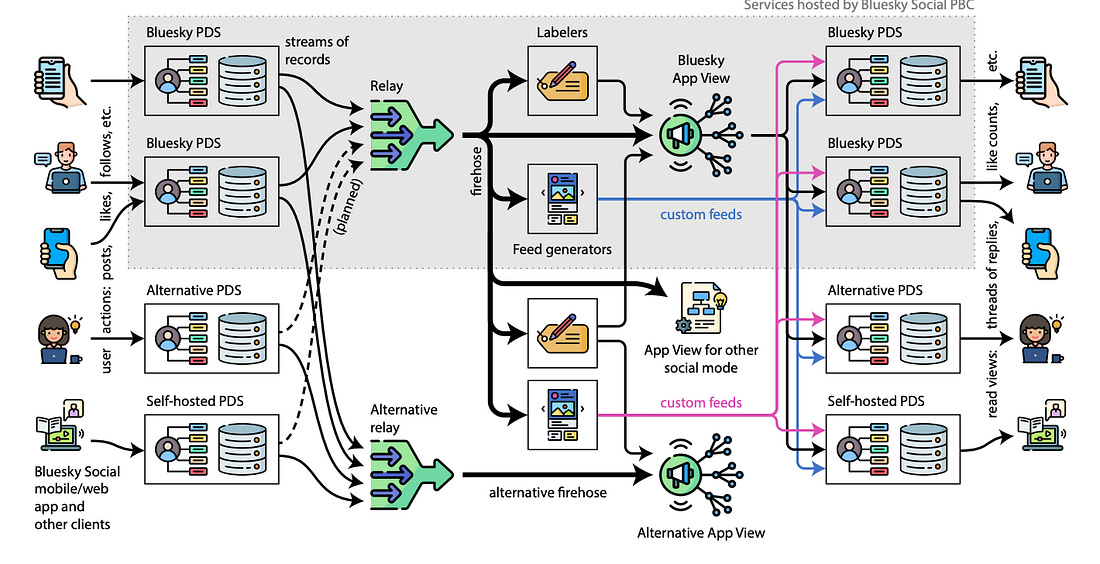
Source: Bluesky and the AT Protocol Why Decentralization is Important?
For years, social media platforms have been controlled by large corporations. These companies create rules, control algorithms, and decide what content gets seen. Much of this happens without transparency.
If they change policies or ban users, there’s little a user can do. This lack of control over personal data and content moderation has led to a push for decentralized social networks, where users can potentially have more freedom and ownership.
However, many existing decentralized platforms come with their own set of challenges:
Users may join independent servers, making it difficult to move to another server without losing identity or followers.
Lack of a global search index, making it hard to discover and interact with new people beyond direct connections.
Lack of structured moderation tools, which means harmful content can spread unchecked.
Bluesky aims to solve these problems through a combination of decentralization and usability by:
Allowing user migration without losing followers, thanks to Decentralized Identifiers (DIDs).
Using Relays to index the entire network, ensuring content is discoverable.
Separating speech from reach, so users can filter content without restricting free expression.
How Does Bluesky Work?
As mentioned, Bluesky is built on the AT Protocol.
The AT Protocol consists of several key components that work together to store, distribute, and curate content without relying on a single centralized entity.
The diagram below shows a high-level architecture of Bluesky’s Federated Architecture.
1 - Personal Data Servers (PDS)
Each user has a repository or a collection of records containing their posts, likes, follows, and other interactions. Also, every action a user takes (for example, posting a message or liking a post) creates a new record in their repository. The repository structure is cryptographically signed to ensure data integrity. Think of the repository as a version-controlled record store (similar to a Git repository).
These repositories are managed by Personal Data Servers (PDS).
A PDS is responsible for storing user data and managing authentication. It is like the user’s agent within the network. You can think of the PDS as a service that runs user repositories, exposing HTTP endpoints and WebSockets for communication.
PDSes can be hosted by companies, independent providers, or even by users themselves, resulting in flexible data ownership.
This does not mean that every user needs to run and manage a PDS on their machine. Similar to how email services work, users can sign up for a PDS hosted by a provider. For example, a user can opt for Bluesky’s default hosting. Bluesky runs many PDSes, where each PDS runs as a completely separate service in the network. More advanced users can self-host their PDS on a private server or VPS.
2 - Relays
Relays act as network-wide content aggregators that collect and distribute user-generated data.
Instead of each user or server handling network-wide indexing, relays create a global index of posts, likes, and social connections to ensure content is discoverable.
They crawl all known PDSes and subscribe to their real-time updates. They also filter out malformed, illegal, or high-volume spam before passing updates to other components.
Bluesky currently operates the default relay, which indexes posts, likes, and follows across the network. However, in the future, third-party organizations, developers, or individuals can run their Relay nodes, allowing for diverse indexing strategies such as community-specific relays, interest-based relays, or censorship-resistant relays.
See the diagram below:
3 - App Views
App Views process data from relays and generate structured feeds that users see in their clients. They store aggregated statistics (like counts of likes and replies) and enforce moderation policies by blocking certain interactions based on user preferences.
Bluesky provides an official App View, which powers the default feed that users see. This App View curates content, applies moderation policies, and displays posts in a user-friendly manner. However, developers and communities can create custom App Views that provide alternative ranking algorithms, filter out certain types of content, and offer specialized feed experiences.
Unlike traditional social networks, where a central company controls recommendation algorithms, Bluesky allows multiple competing App Views that users can choose from. Users can also choose multiple App Views based on their preferences.
How Do These Components Work Together?
Here’s a simple process flow that demonstrates how the various components come together to support the Bluesky experience:
A user writes a post using the Bluesky app. Each post requires two fields: text and createdAt (timestamp). The post is stored as a record in their PDS and added to their cryptographically signed repository. This repository acts like a public ledger, making it easy to verify that the content has not been altered.
The user’s PDS pushes updates to a relay that verifies the signature and stores a copy of the record. The relay notifies all App Views and feed generators that a new post is available.
App Views query the relay for new content, fetch relevant posts, and apply moderation rules if necessary. They generate custom feeds based on user preferences and display them in client apps.
When another user likes or replies to the post, their PDS creates a new record reflecting this action. This action is sent to the relay, which updates the global index. The original poster’s App View retrieves the latest interaction and updates the post’s engagement statistics.
The diagram below tries to show this flow:
User Identity and Account Portability in Bluesky
Bluesky is designed to give users full control over their identity, making it different from traditional social media platforms, where accounts are locked to a single service provider.
The AT Protocol uses Decentralized Identifiers (DIDs) as persistent, long-term account identifiers to create permanent user identities independent of any single server or provider.
A DID is a cryptographic identifier that uniquely represents a user across the network.
Unlike traditional usernames tied to a specific server, a DID remains the same even if the user switches providers.
The DID is recorded in a distributed registry so that it cannot be altered or deleted by a hosting provider.
Each DID has two key pairs:
Signing Key: Used to verify user actions like posting or liking content.
Recovery Key: Helps the user restore access to their identity if their primary key is lost or compromised.
DIDs provide a self-sovereign identity, meaning that users own and control their identity without reliance on a central authority. While users have a DID, they also have a readable username for easier recognition. For example: “@username.bsky.social”.
Migration Between Servers
One of the biggest challenges in federated social networks is account migration. Here’s how it works in Bluesky.
A user signs up with a hosting provider (Personal Data Server) and their data is linked to their DID.
If the user wants to migrate to another provider, they export their repository and update their DID to point to the new PDS.
Since followers, posts, and interactions are stored in signed, portable repositories, migration is seamless. Followers do not need to re-follow the user.
This system allows users to change providers without losing their identity or network. Users can also retain their social graph even if a provider shuts down. Users can also host their PDS if they prefer self-sovereignty over third-party hosting.
Security and Privacy Considerations
Since each DID is cryptographically linked to the user’s identity, it cannot be forged or stolen.
Even if a hacker takes over a username (“@someone.bsky.social”), they cannot impersonate the original DID, preventing identity theft. Users can verify each other’s identity using DID resolution tools, similar to how SSL certificates validate websites.
Users have a recovery key that allows them to regain control over their account in case of a security breach.
Content Discovery and Custom Feeds in Bluesky
Content discovery and feeds are one of Bluesky’s key innovations.
In Bluesky, content is not stored on a single server or database. Instead, relays act as global content indexers that aggregate and distribute posts across the network.
Here’s what the relays do:
They continuously crawl Personal Data Servers (PDSes) to collect and update posts, likes, and follows.
They store indexed metadata (such as post timestamps, authorship, and interactions) to enable fast content discovery.
When a user searches for a post or follows someone, their client app queries the relay, which returns relevant results based on the indexed data.
In a traditional social media platform, the company that owns the service also decides how content is ranked and displayed in user feeds. This often leads to non-transparent algorithmic filtering, where users are shown posts based on engagement metrics.
Bluesky removes this centralized control by introducing App Views, which play the role of independent feed curators. Developers can create publicly available feed generators anyone can subscribe to. These feeds may focus on specific topics such as technology news, verified accounts, or trending discussions.
Moderation and Content Control in Bluesky
In Bluesky, users can post anything they want. Their PDS stores these records, ensuring that their content remains available. No single authority can delete a post from the entire network. Even if a provider refuses to display it, the data remains intact in the user’s repository.
However, just because a post exists does not mean it will be indexed, promoted, or widely visible. Moderation services and App Views determine how content appears in feeds and searches. This means harmful or offensive content can be downranked, filtered, or hidden, but not erased from a user’s storage.
This concept is called “separation of speech and reach”, which allows for free expression while maintaining content control at different levels.
Labelers and Moderation Services
Bluesky does not enforce a single, centralized moderation system. Instead, it allows multiple independent moderation services, which work together to flag, filter, and categorize content. This includes:
Network takedowns which filter the content from the APIs.
Labels placed on content by moderation services.
User controls such as mutes and blocks.
Labelers are third-party moderation services that tag content with appropriate labels. Imagine a label as a metadata to categorize the content. These labels do not remove content but allow App Views and users to apply filters based on their preferences. Users can choose which Labelers they trust, meaning moderation is customizable rather than forced. All of this information is stored on the user’s data server.
Bluesky provides both individual-level and community-level blocking tools to ensure user safety and content control. Some features are as follows:
Users can block individuals, preventing them from seeing or interacting with their posts.
Users can subscribe to blocklists maintained by third-party moderation groups.
Blocking is publicly visible, meaning other users can see when someone is blocked. This helps prevent users from repeatedly engaging with people who have blocked them.
Conclusion
Bluesky represents a major step forward in decentralized social networking, offering a platform where users have true control over their identity, data, and content experience.
Through the AT Protocol, Bluesky ensures that social interactions remain scalable, transparent, and resistant to corporate control.
Looking ahead, Bluesky’s future will be shaped by user adoption, third-party innovation, and continued improvements to the AT Protocol. Some key expected developments include:
Expansion of App Views and Feed Generators: Encouraging greater diversity in content discovery.
Increased Relay and Moderation Services: Creating more robust, user-driven content curation.
Integration with Other Decentralized Systems: Expanding interoperability across web3 and federated platforms.
References:
SPONSOR US
Get your product in front of more than 1,000,000 tech professionals.
Our newsletter puts your products and services directly in front of an audience that matters - hundreds of thousands of engineering leaders and senior engineers - who have influence over significant tech decisions and big purchases.
Space Fills Up Fast - Reserve Today
Ad spots typically sell out about 4 weeks in advance. To ensure your ad reaches this influential audience, reserve your space now by emailing sponsorship@bytebytego.com.
Like
Comment
Restack
© 2025 ByteByteGo
548 Market Street PMB 72296, San Francisco, CA 94104
Unsubscribe
by "ByteByteGo" <bytebytego@substack.com> - 11:36 - 25 Mar 2025 -
centimeter accuracy indoor locationing handheld V570
hi info,
Connie here recommend you a nice full touch screen android rugged handheld mobile terminal.
V570 suports UWB indoor centimeter level accuracy, a good device for hospitals, warehouse, healthcare industries, restaurants.etc.Please check below spec,- 5.7'' android12
- White&blue, black housing options
- 4gb 64gb
- 2d scanner docking charger, scan gun options
- NFC 13.56MHz built in
- GPS, 4G LTE, WIFI roaming, BLUETOOTH built in
- Support customized power on logo
- Sample lead time:72hours
- Delivery time:6-9days
- Trade term:EXW shenzhen
It can do antibacterial housing,if interested and need price, please contact Connie. ____________________________________________Best Regards
____________________________________________Best Regards
Connie LuAccount managerShenzhen SWELL TechSkype: 0086-15728538330 Wechat/whatsapp: 0086-15012754294
Tel: 0086-755-29031883 Fax: 0086-755-29648701
Email: sales9@swellsz.com Web: www.ruggedi.comAlibaba certified 15 years gold supplier
by "Alejos Adib" <adibalejos@gmail.com> - 04:53 - 25 Mar 2025 -
What’s next for dinner: The fermented-food revolution
On McKinsey Perspectives
Sizing the 2050 market Brought to you by Alex Panas, global leader of industries, & Axel Karlsson, global leader of functional practices and growth platforms
Welcome to the latest edition of Only McKinsey Perspectives. We hope you find our insights useful. Let us know what you think at Alex_Panas@McKinsey.com and Axel_Karlsson@McKinsey.com.
—Alex and Axel
•
A biotech revolution. Fermentation, a type of bioprocessing, enables food producers to create proteins and other ingredients using microbes instead of animals, which reduces land use and emissions while enhancing reliability and food security. McKinsey Senior Partner Daniel Aminetzah and coauthors say that by 2050, fermented novel proteins could make up about 4% of the world’s protein production. This represents an annual market of $100 billion to $150 billion, depending on climate policies and the pace of technological development.
—Edited by Belinda Yu, editor, Atlanta
This email contains information about McKinsey's research, insights, services, or events. By opening our emails or clicking on links, you agree to our use of cookies and web tracking technology. For more information on how we use and protect your information, please review our privacy policy.
You received this email because you subscribed to the Only McKinsey Perspectives newsletter, formerly known as Only McKinsey.
Copyright © 2025 | McKinsey & Company, 3 World Trade Center, 175 Greenwich Street, New York, NY 10007
by "Only McKinsey Perspectives" <publishing@email.mckinsey.com> - 01:50 - 25 Mar 2025 -
[JUST RELEASED!] Gary Vee & Russell Brunson Masterclass
How to go viral, build a brand, and win a 'Two Comma Club' award!Hey - it’s Russell!
Are you ready…
We dug deep into the vault this week, and what we found was an EPIC throwdown between yours truly and the one and only Gary Vee!
OK… maybe it wasn’t a throwdown, haha! But it was definitely some solid marketing “theories and opinions” being tossed back and forth.
We were talking viral marketing… I was coming from a “funnels” angle, and Gary Vee was coming from a “branding” angle…
And the Harmon Bros (AKA the viral video gurus) got involved too!
We’re showing it all to you this week ONLY in the:
Gary Vee & Russell Brunson Masterclass!
Round one… Russell Brunson!! ⬇️⬇️⬇️
GO WATCH MY PRESENTATION FROM THE FUNNELS VS BRANDING MASTERCLASS HERE >>
I’m starting things off by sharing my behind-the-scenes look at ClickFunnels’ mission and how we grew from ZERO to $100,000,000 so fast, and what made our viral launch so powerful!
I break it down into THREE KEY POINTS every movement needs to get traction and succeed!
I cover them in my first video!
GO WATCH MY PRESENTATION FROM THE GARY VEE & RUSSELL BRUNSON MASTERCLASS HERE >>
Keep an eye on your inbox for tomorrow’s video where Gary Vee does the most wild Q & A session you don’t wanna miss!!
See you tomorrow,
Russell Brunson
P.S. - Don’t forget, you’re just one funnel away….
© Etison LLC
By reading this, you agree to all of the following: You understand this to be an expression of opinions and not professional advice. You are solely responsible for the use of any content and hold Etison LLC and all members and affiliates harmless in any event or claim.
If you purchase anything through a link in this email, you should assume that we have an affiliate relationship with the company providing the product or service that you purchase, and that we will be paid in some way. We recommend that you do your own independent research before purchasing anything.
Copyright © 2018+ Etison LLC. All Rights Reserved.
To make sure you keep getting these emails, please add us to your address book or whitelist us. If you don't want to receive any other emails, click on the unsubscribe link below.
Etison LLC
3443 W Bavaria St
Eagle, ID 83616
United States
by "Russell @ ClickFunnels" <noreply@clickfunnelsnotifications.com> - 10:40 - 24 Mar 2025 -
Over Three Decades of Craftsmanship – Providing You with High-Quality Printing Chemicals
Dear info,
Hello!
SOPHAH SCREEN PRINTING TECHNOLOGY LTD., established in 1988, has been deeply rooted in the Chinese market for over three decades, specializing in the research and development of printing chemicals. We understand our customers' needs and the challenges of the industry, and we continuously optimize our products and services to provide high-performance and environmentally friendly inks, cleaners, and dampening solutions.
Thank you for your continued support and trust! We look forward to continuing to provide you with high-quality products and services to support your business growth.
If you need any assistance or consultation, please feel free to contact us!
Best regards,
Alex Chou
Factory Base: No. 3 TengHuaXi Rd, LuBao Industrial Zone, SanShui District, Foshan City, GuangDong Province, China
Tel.: +86 0757 85765678 (20 hotlines);
Fax: +86 0757 85765555
Mobile:
CN: +86 15913119191
WhatsApp: +8615913119191
Email: alexchow@xinyi-chem.com
by "Mowris Nimmons" <mowrisnimmons@gmail.com> - 06:07 - 24 Mar 2025 -
Affordable Adjustable Swivel Stools – Custom OEM/ODM
Hi Sir/Ms
I’m Allen from Hangzhou Mingchen Furniture Co., Ltd., a furniture manufacturer with 15 years of experience.
We offer round stool with backrest (360° rollers, height adjustable) at competitive price. We can add your logo on the product or carton, and accept OEM/ODM orders.
Let me know if you’d like a quote or samples!

Best regards
Allen
Sales Manager
WeChat:A19157900359
WhatsAPP:+86 19157900359
HANGZHOU MINGCHEN FURNITURE CO.,LTD.
www.dhksy.com
by "sales10" <sales10@f-directlywholesale.com> - 12:18 - 24 Mar 2025 -
Learn from the best: A leader’s guide to excelling as a CEO
Leading Off
Winning ways Brought to you by Alex Panas, global leader of industries, & Axel Karlsson, global leader of functional practices and growth platforms
Welcome to the latest edition of Leading Off. We hope you find our insights useful. Let us know what you think at Alex_Panas@McKinsey.com and Axel_Karlsson@McKinsey.com.
—Alex and Axel
Exciting. Rewarding. Overwhelming. Lonely. These are just some of the words that describe what it can feel like to serve as a CEO. To help leaders at the top navigate this multifaceted and demanding role, a team of McKinsey senior partners interviewed high-performing CEOs and synthesized their experiences in CEO Excellence: The Six Mindsets That Distinguish the Best Leaders from the Rest. The book, which marks its third anniversary this month, offers lessons on handling core CEO responsibilities, such as setting strategic direction and aligning the organization—and managing personal effectiveness, too. (A follow-up book, A CEO for All Seasons: Mastering the Cycles of Leadership, will be published in October.) This week, we explore insights from CEO Excellence and look at some of the practices that can help leaders thrive in the top job.
Being a CEO means balancing the big picture with a disciplined daily routine. Based on feedback from more than 100 leaders as well as interviews conducted for CEO Excellence, McKinsey’s Gautam Kumra, Joydeep Sengupta, Mukund Sridhar, and coauthors identify the everyday habits that help the best CEOs juggle their professional responsibilities with their personal priorities. For example, many CEOs create short summaries of their companies’ missions to help them uphold their core duty of setting strategic direction. Some CEOs also stay engaged with their boards of directors by providing the chairs with daily or weekly updates. And some regularly celebrate victories as a group to help empower their leadership teams. “While CEOs get most of the public accolades for their organizations’ successes, the best leaders ensure that employees receive due credit,” the authors say.
That’s the average number of years that new CEOs have worked before taking the top job. CEO Excellence authors Carolyn Dewar, Scott Keller, and Vikram Malhotra, along with Senior Partner Kurt Strovink (who coauthors A CEO for All Seasons with them), observe that the success of new CEOs depends on their ability to learn how to lead differently and revamp many of the work habits they have built up throughout their careers. “The best CEOs don’t miss the opportunity to make their first six to 12 months—not just the vaunted 100 days—both a personal transition of great import and a profound moment of institutional renewal,” the authors say.
That’s McKinsey Senior Partner Ramesh Srinivasan on why CEOs must make time for self-reflection, in an episode of The McKinsey Podcast. Srinivasan is a coauthor of The Journey of Leadership: How CEOs Learn to Lead from the Inside Out, which contends that CEOs must augment traditional leadership qualities, such as decisiveness and confidence, with self-awareness, humility, compassion, and other soft skills. In the same interview, McKinsey’s Hans-Werner Kaas (another coauthor) says that “human-centric leadership provides the permanent guidepost for leaders of all backgrounds and levels. That guidepost, plus the actions leaders take to get to it, is central for colleagues and external stakeholders to look up to.”
As CEO of Otis Worldwide Corporation, Judy Marks is guiding the venerable elevator manufacturer through its latest period of uncertainty and change. She’s also learning how nimble and adaptable CEOs need to be, especially at a global company. “What I think people don’t know about are the real-time challenges,” she says in an episode of the Inside the Strategy Room podcast. “The pace of change is so exponentially faster than anything I’ve experienced in my career.” Marks stresses that new CEOs should understand that some strategic decisions can’t wait until they gather every fact and get full consensus from their teams. “The decision is in that seat and that chair,” she says. “Then, if you made the wrong one, you need to admit it.”
Business and sports have long been intertwined, as anyone who’s been told by their boss to “swing for the fences” or “run a full-court press” can attest. Many CEOs and senior executives have athletic backgrounds and find that those experiences helped prepare them for corporate success. Of course, you don’t need an all-star pedigree to become a CEO. But you can become a better leader by adopting some of the common practices of top athletes, say McKinsey’s Global Managing Partner Bob Sternfels and Senior Partner Daniel Pacthod. Today’s sports stars are more prepared and proficient than previous generations because they are continually learning, they embrace data and analytics, and they are adaptable and resilient, among other traits. “The best leaders today have made a generational change in their thinking, one that closely parallels how elite athletes prepare, train, and compete,” the authors say. “In several ways, the two jobs—CEO and athlete—are highly correlated.”
Lead by building winning habits.
— Edited by Eric Quiñones, senior editor, New York
Share these insights
Did you enjoy this newsletter? Forward it to colleagues and friends so they can subscribe too. Was this issue forwarded to you? Sign up for it and sample our 40+ other free email subscriptions here.
This email contains information about McKinsey’s research, insights, services, or events. By opening our emails or clicking on links, you agree to our use of cookies and web tracking technology. For more information on how we use and protect your information, please review our privacy policy.
You received this email because you subscribed to the Leading Off newsletter.
Copyright © 2025 | McKinsey & Company, 3 World Trade Center, 175 Greenwich Street, New York, NY 10007
by "McKinsey Leading Off" <publishing@email.mckinsey.com> - 04:36 - 24 Mar 2025 -
Key issues for operations leaders in 2025—and beyond
On McKinsey Perspectives
Collaboration is critical Brought to you by Alex Panas, global leader of industries, & Axel Karlsson, global leader of functional practices and growth platforms
Welcome to the latest edition of Only McKinsey Perspectives. We hope you find our insights useful. Let us know what you think at Alex_Panas@McKinsey.com and Axel_Karlsson@McKinsey.com.
—Alex and Axel
•
Thrive in 2025. As corporate leaders grapple with ongoing uncertainty and change in the business environment, it’s seemingly harder than ever to plan ahead. At the same time, some things are becoming clearer. For instance, gen AI and other cutting-edge technologies have reached an inflection point, McKinsey Senior Partners Daniel Swan and Ruth Heuss reflect in an episode of McKinsey Talks Operations. Swan notes that in 2024, companies that effectively leveraged their technology and operations started to differentiate themselves from those that didn’t. When people “apply tech, digital, and gen AI solutions to more traditional things, like process improvement and capability building, we can unlock really exciting productivity improvements,” he shares.
—Edited by Belinda Yu, editor, Atlanta
This email contains information about McKinsey's research, insights, services, or events. By opening our emails or clicking on links, you agree to our use of cookies and web tracking technology. For more information on how we use and protect your information, please review our privacy policy.
You received this email because you subscribed to the Only McKinsey Perspectives newsletter, formerly known as Only McKinsey.
Copyright © 2025 | McKinsey & Company, 3 World Trade Center, 175 Greenwich Street, New York, NY 10007
by "Only McKinsey Perspectives" <publishing@email.mckinsey.com> - 01:43 - 24 Mar 2025 -
odoo enquiry: odoo services
Hello,Greetings from Cybrosys Technologies!!!
Thank you for reaching out to us and showing interest in our odoo services. We would be glad if we get an opportunity to deal with your company and provide quality service in ODOO. You can get to know about our company from our website: www.cybrosys.comWe, Cybrosys Technologies are Odoo official certified partners based in UK , India. We are mainly into ODOO for the past 15+ years , expertised in both community and enterprise editions. Cybrosys have already implemented more projects for our valued clients. This has given us the skills and expertise to deliver every project with supreme ease. Now, we are ready to join hands with those businesses that require Odoo assistance and ERP Implementation to Grow their business and we are committed to their success.We provide passionate and experienced odoo developers and odoo functional consultants to our end users and odoo partners. Our experts showcase the best service in odoo with their proven domain knowledge.We provide services in all industry specifics and provide exclusive support in all versions and editions of Odoo. We follow agile methodology to comply with industry standards. We offer Odoo Consultancy services, Integrations, Migrations, Building Customized Solutions, Training, etc.It's easy to find the perfect match from our network of talented and experienced development teams. We are equipped to help you regardless of any kind of support you may need in odoo. As your company grows, as your partner, we will be there with you every step of the way.If you have a business need or idea that you have been dwelling on for a long time, our Odoo experts will understand your needs and based on that can avail you a solution. Let me know your availability for a call to hear your objectives and based on that we can avail you the solution. Do you have a document specification of your required needs in odoo?We are armed with a talented team of 300+ Odoo Developers who are guided by team leads and project managers who are fully-equipped to turn any idea into a reality. We can outsource our experts to assist on the implementation, customization, migration,integration, training and support needs in odoo.You are not only getting a dedicated expert but there will be a team lead to guide and monitor your work. Also you will get the complete expertise of Cybrosys as required during the outsourcing period. We assure you the quality in our deliverables.You can check the coding standards of our experts from the 1000+ apps we have already listed in odoo apps.Please feel free to reach me out in Skype: cybrosystech, WhatsApp: +919544090359We look forward to hearing from you soon. Hope it will be a great start for a successful business relationship with your company. Cybrosys will serve you in the best way to accomplish your odoo needs.
Thanks & Regards,
Celine George
Sr. Business Development Officer
Marketing Department
Cybrosys Technologies
Mail
Mobile
WhatsApp
Skype
+91 9544090359
+91 9544090359
cybrosystech
by "Celine George" <celinegeorge@cybrosys.com> - 11:35 - 23 Mar 2025-
Re: odoo enquiry: odoo services
Hello,You can find more details here aboutEmployee Self-Service & Maintenance Management
Thanks & Regards,
Celine George
Sr. Business Development Officer
Marketing Department
Cybrosys Technologies
Mail
Mobile
WhatsApp
Skype
+91 9544090359
+91 9544090359
cybrosystech
On Mon, 24 Mar 2025 at 9:05 AM, Celine George <celinegeorge@cybrosys.com> wrote:
Hello,Greetings from Cybrosys Technologies!!!
Thank you for reaching out to us and showing interest in our odoo services. We would be glad if we get an opportunity to deal with your company and provide quality service in ODOO. You can get to know about our company from our website: www.cybrosys.comWe, Cybrosys Technologies are Odoo official certified partners based in UK , India. We are mainly into ODOO for the past 15+ years , expertised in both community and enterprise editions. Cybrosys have already implemented more projects for our valued clients. This has given us the skills and expertise to deliver every project with supreme ease. Now, we are ready to join hands with those businesses that require Odoo assistance and ERP Implementation to Grow their business and we are committed to their success.We provide passionate and experienced odoo developers and odoo functional consultants to our end users and odoo partners. Our experts showcase the best service in odoo with their proven domain knowledge.We provide services in all industry specifics and provide exclusive support in all versions and editions of Odoo. We follow agile methodology to comply with industry standards. We offer Odoo Consultancy services, Integrations, Migrations, Building Customized Solutions, Training, etc.It's easy to find the perfect match from our network of talented and experienced development teams. We are equipped to help you regardless of any kind of support you may need in odoo. As your company grows, as your partner, we will be there with you every step of the way.If you have a business need or idea that you have been dwelling on for a long time, our Odoo experts will understand your needs and based on that can avail you a solution. Let me know your availability for a call to hear your objectives and based on that we can avail you the solution. Do you have a document specification of your required needs in odoo?We are armed with a talented team of 300+ Odoo Developers who are guided by team leads and project managers who are fully-equipped to turn any idea into a reality. We can outsource our experts to assist on the implementation, customization, migration,integration, training and support needs in odoo.You are not only getting a dedicated expert but there will be a team lead to guide and monitor your work. Also you will get the complete expertise of Cybrosys as required during the outsourcing period. We assure you the quality in our deliverables.You can check the coding standards of our experts from the 1000+ apps we have already listed in odoo apps.Please feel free to reach me out in Skype: cybrosystech, WhatsApp: +919544090359We look forward to hearing from you soon. Hope it will be a great start for a successful business relationship with your company. Cybrosys will serve you in the best way to accomplish your odoo needs.
Thanks & Regards,
Celine George
Sr. Business Development Officer
Marketing Department
Cybrosys Technologies
Mail
Mobile
WhatsApp
Skype
+91 9544090359
+91 9544090359
cybrosystech
by "Celine George" <celinegeorge@cybrosys.com> - 11:41 - 23 Mar 2025
-
-
(Video #7 Funnel Install) Perry Belcher’s Tripwire Funnel
He’s sold over $900 million worth of products with this framework!You did it!!!
We made it to Day 7 of the Funnel Install series!
Here’s what we’ve covered so far…
✅ Day 1 - Trey Lewellen’s e-commerce funnel
✅ Day 2 - Dan Henry's webinar funnel
✅ Day 3 - Jeff Walker’s product launch funnel
✅ Day 4 - Pedro Adao's challenge funnel
✅ Day 5 - Steve Larsen’s affiliate funnel
✅ Day 6 - Gabe Schillinger’s viral giveaway funnel
And now to wrap it all up you get to hear from Perry Belcher!
GO HERE TO WATCH THE VIDEO FROM PERRY BELCHER AND STEAL HIS TRIPWIRE FUNNEL FOR FREE! >>
Most people struggle to turn cold traffic into buyers…. But Perry cracked the code by offering something
So irresistible…
So low-risk…
People can’t say no!!
And just like all the other experts this week… Perry’s handing you the exact Tripwire Funnel he uses!!
GO HERE TO WATCH THE VIDEO FROM PERRY BELCHER AND STEAL HIS TRIPWIRE FUNNEL FOR FREE! >>
Now… let’s talk about what happens next.
Over the last 7 days, you’ve received 7 of the most proven, battle-tested funnels in the world.
I repeat… IN. THE. WORLD!!!
But having these funnels means nothing if you don’t put them to work in your business.
That’s where ClickFunnels comes in.
These funnels were built for ClickFunnels… and when you have an account, you can install them within minutes and customize them for your business, products, or services.
No coding.
No complicated setup.
Just plug and play.
If you don’t have a ClickFunnels account yet, now is the time.
Start your free 2-week trial today and get these 7 funnels LIVE AND WORKING in your business.
CLICK HERE FOR MY SPECIAL 2-WEEK FREE TRIAL FOR CLICKFUNNELS >>
You’ve watched these experts explain the path forward over the last week… This is your chance to shortcut YEARS of trial and error.
You’ve got the blueprints. You’ve got the training. Now it’s time to take action!!!
CLICK HERE FOR MY SPECIAL 2-WEEK FREE TRIAL FOR CLICKFUNNELS >>
Thanks for being part of this Funnel Install series!
I can’t wait to see what you build!
And I can’t wait to see you getting your 2-Comma Club Award next year!! (It won’t be on an FHL stage, but we’ve got some cool plans in the works, so it will still be super cool!!!)
Let’s do this!
Russell Brunson
P.S. - Don’t forget, you’re just one funnel away….
© Etison LLC
By reading this, you agree to all of the following: You understand this to be an expression of opinions and not professional advice. You are solely responsible for the use of any content and hold Etison LLC and all members and affiliates harmless in any event or claim.
If you purchase anything through a link in this email, you should assume that we have an affiliate relationship with the company providing the product or service that you purchase, and that we will be paid in some way. We recommend that you do your own independent research before purchasing anything.
Copyright © 2018+ Etison LLC. All Rights Reserved.
To make sure you keep getting these emails, please add us to your address book or whitelist us. If you don't want to receive any other emails, click on the unsubscribe link below.
Etison LLC
3443 W Bavaria St
Eagle, ID 83616
United States
by "Russell @ ClickFunnels" <noreply@clickfunnelsnotifications.com> - 09:25 - 23 Mar 2025 -
Invitation
Good Day Sir/Madam,
Hope this email finds you well. We are pleased to invite you or your company to quote the following item
listed below:Product/Model No: PAME PLS888117 CTB FORGED 20K GLOBE VALVE
Model Number: PLS888117
Port Size: DN80
Pressure Rating: PN16
Material: stainless steel 316
Qty. 55
Compulsory, Kindly send your quotation to: orders@shellsupplychain.com
for immediate approval.Kind Regards,
Kenneth Benthem
Global Head of Procurement & Supply Chains
SHELL GLOBAL SOLUTIONS INTERNATIONAL BV
Address: Grasweg 39, 1031 HW Amsterdam, Netherlands.
VAT: NL804013019B01
Tel: +31 85 064 4637
Fax: +31 62 273 6114
by "Shell Global" <cimorelli@aruba.it> - 08:04 - 23 Mar 2025 -
The quarter’s top themes
McKinsey&Company
At #1: AI explained: Test your knowledge In the first quarter of 2025, our top ten posts from McKinsey Themes highlight topics including gen AI, leadership, and the luxury sector. At No. 1 is AI explained: Test your knowledge, which explores the basics and future of AI with insights by McKinsey’s Ida Kristensen, Alex Singla, Kate Smaje, Alex Sukharevsky, and more. Read on for our full top 10.
3. What does it take to be a leader at a company?
“As the world grows more complicated, so must our perceptions of and approaches to leadership development,” write McKinsey’s global managing partner Bob Sternfels and coauthors. CEOs and top teams must make decisions while focusing on multiple critical issues at one time, so what does it take to be a leader in today’s fragmented world? Gen AI, mergers, and more
On Leap Day 1996, McKinsey.com went live on the internet and immediately garnered readership from 20 countries. Since then, the site has grown into a treasure trove of insights in the form of learning journeys, interactives, podcasts, quizzes, reports, videos, compendiums, blogs, and more. Read all about it
Share these insights
This email contains information about McKinsey’s research, insights, services, or events. By opening our emails or clicking on links, you agree to our use of cookies and web tracking technology. For more information on how we use and protect your information, please review our privacy policy.
You received this email because you are a registered member of the Top Ten Most Popular newsletter.
Copyright © 2025 | McKinsey & Company, 3 World Trade Center, 175 Greenwich Street, New York, NY 10007
by "McKinsey Top Ten" <publishing@email.mckinsey.com> - 10:26 - 23 Mar 2025












